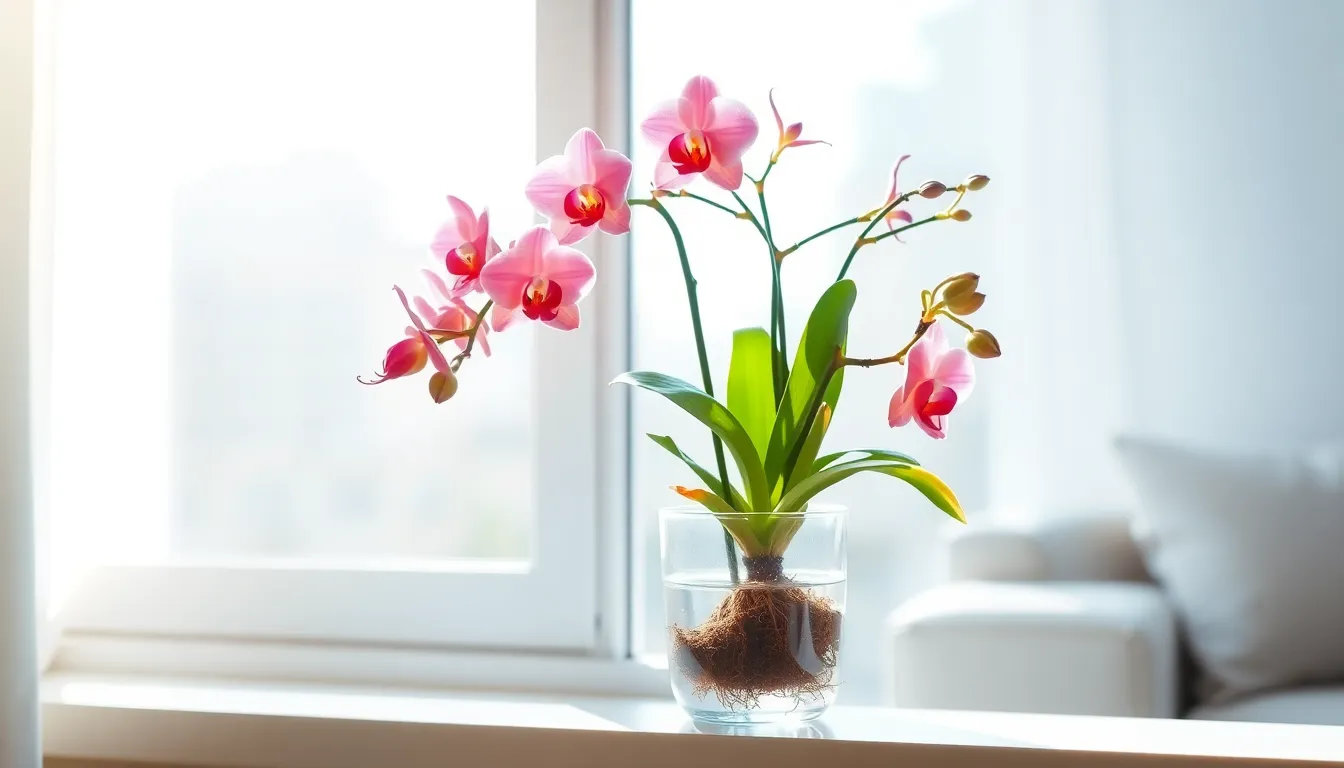Orchids are the divas of the plant world, demanding just the right amount of attention and care to thrive. With their stunning blooms and exotic appeal, they can transform any space into a tropical paradise. But don’t let their beauty fool you—caring for an orchid can feel like trying to solve a Rubik’s Cube blindfolded.
Table of Contents
ToggleUnderstanding Orchid Plants
Orchids present unique beauty along with specific care needs. Recognizing their characteristics and species aids in proper maintenance.
Common Orchid Species
Phalaenopsis, commonly known as moth orchids, represent the most popular type due to their long-lasting blooms and forgiving nature. Cattleya orchids, recognized for their large, fragrant flowers, thrive in warm climates and require bright light. Oncidium orchids produce clusters of small blossoms, creating a lively display in indoor spaces. Dendrobium orchids, with their upright stems, prefer cooler conditions and can flourish outdoors in specific regions. Each species exhibits distinct characteristics, adapting to various environments and care routines.
Orchid Plant Characteristics
Orchids exhibit diverse characteristics that differentiate them from other plants. They possess thick, fleshy leaves which store water, enabling resilience during dry periods. Roots emerge not only from the soil but also cling to surfaces, allowing access to nutrients and moisture. Flowers feature a unique structure with a highly symmetrical shape, often showcasing vivid colors and intricate patterns. Growth habits vary, with some orchids growing pseudobulbs for moisture storage, while others form symbiotic relationships with fungi. Understanding these characteristics assures better care and flourishing plants.
Essential Care Tips

Orchids require specific care to thrive properly. Focusing on their needs ensures vibrant blooms and healthy growth.
Watering Requirements
Watering orchids involves balancing moisture levels. Most orchids thrive when the potting medium dries slightly between waterings. Checking the roots helps determine the moisture level; green roots indicate enough water, while brown roots signal drought. In general, watering once every 1-2 weeks in spring and summer works well. During fall and winter, this frequency may drop to every 2-3 weeks. Adjusting watering according to environmental conditions increases the chances of successful growth.
Light Preferences
Light plays a crucial role in orchid health. They typically flourish in bright, indirect sunlight. Positioning orchids near east or west-facing windows provides optimal light exposure. Avoiding direct sunlight helps prevent leaf scorch. For those using artificial light, choosing fluorescent lights can promote growth effectively. Monitoring leaf color can indicate light levels; dark green leaves often suggest insufficient light, while yellowing leaves may point to too much exposure.
Temperature and Humidity Needs
Temperature and humidity significantly affect orchids. Many varieties thrive at temperatures between 65°F and 80°F during the day. Nighttime temperatures should ideally drop 10-15°F for a natural cycle. Maintaining humidity around 40-70% contributes to healthy growth. Using a humidity tray or a room humidifier enhances the environment. Regularly misting orchids can also boost humidity levels, ensuring they remain happy and healthy.
Fertilizing Your Orchid
Fertilizing orchids properly enhances their growth and blooms. Knowing how to select the right fertilizer and when to apply it helps achieve optimal results.
Choosing the Right Fertilizer
Select a balanced fertilizer formulated for orchids, typically featuring a nutrient ratio of 30-10-10. Look for options providing nitrogen, phosphorus, and potassium, crucial for healthy growth. Granular and liquid fertilizers both work effectively; however, liquid variants offer easier application and faster absorption. Opt for a fertilizer with added micronutrients, ensuring a well-rounded nutrient profile. Some gardeners prefer organic fertilizers, which can improve the potting medium over time while providing essential nutrients.
Fertilization Schedule
Fertilizing orchids every two weeks is recommended during the growing season, which generally spans spring and summer. Use the same frequency every month during the dormant months of fall and winter. Apply the fertilizer after watering, ensuring the potting medium remains moist but not saturated. Following this practice prevents root burn from concentrated fertilizer. Adjustments may be necessary based on specific orchid species, so monitor their response and adjust the frequency accordingly for the best results.
Repotting Orchids
Repotting orchids helps maintain their health and promotes growth. Regular repotting supports root development and refreshes the potting medium.
When to Repot
Repotting occurs every 1-3 years. Signs indicating it’s time include roots growing out of the pot or media breaking down. After blooming is the ideal time for repotting, as the plant requires less energy for flower production. Observing root health also aids in deciding when to repot; roots should be firm and white or green. Stressing the plant during the active growing season may impact bloom potential.
How to Repot an Orchid
Gather supplies before starting. A clean pot slightly larger than the current one, fresh orchid potting medium, and clean tools will ensure the process runs smoothly. Remove the orchid from its pot, gently untangle roots if they’re bound. Trim away dead roots using sterilized scissors to prevent disease. Place the plant in its new pot and fill in any gaps with fresh medium, ensuring roots remain visible above the medium line. Water lightly after repotting and avoid fertilizing for a month to reduce stress on the plant.
Common Issues and Solutions
Orchids face several challenges that can affect their growth. Addressing these issues promptly ensures healthy plants and vibrant blooms.
Pest Management
Common pests include aphids, mealybugs, and spider mites. To control these insects, regularly inspect the leaves and roots. A mixture of water and dish soap effectively removes pests. Treat infested areas by spraying this solution directly onto the affected spots. Neem oil offers another option for combating infestations, acting as both a pesticide and fungicide. Keeping the orchids clean and dust-free aids in prevention. Regularly check for signs of pest activity to catch issues early.
Identifying and Treating Diseases
Orchids may develop diseases like root rot or leaf spot. Root rot typically occurs from overwatering and poor drainage. Signs include yellowing leaves and mushy roots. To treat this, remove the orchid from its pot, trim damaged roots, and repot in fresh, dry medium. Leaf spots often stem from fungal infections or excessive moisture. Applying a fungicide can help manage these issues. Monitoring humidity levels reduces the risk of diseases. Adjusting care practices addresses these common health threats effectively.
Caring for an orchid plant may seem daunting but the rewards are truly worth the effort. With the right attention to watering, light, temperature, and humidity, these stunning plants can flourish beautifully. Regular monitoring and adjustments based on specific needs will lead to healthier orchids and more vibrant blooms.
By understanding their unique characteristics and care requirements, anyone can enjoy the exotic charm that orchids bring to their home. Whether it’s through proper fertilization or timely repotting, each step taken contributes to the overall well-being of these remarkable plants. Embracing the journey of orchid care can transform any space into a lush oasis filled with elegance and beauty.





